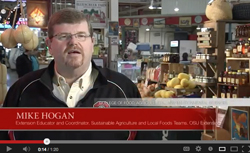A program delivered through CFAES will help disabled Ohioans continue to farm, and you can learn more about it in an upcoming event.

A program delivered through CFAES will help disabled Ohioans continue to farm, and you can learn more about it in an upcoming event.


In summer 2019, CFAES formed a task force to help Ohio farmers and their families deal with the state’s ongoing farming crisis, a crisis caused by record spring rains, new international tariffs, and low commodity prices.
The new Rural and Farm Stress Task Force helped bring mental health issues—and helpful mental health services—into the light, as did the Ohio Department of Agriculture’s Ohio’s Got Your Back campaign, which launched the same summer with CFAES as one of its partners.
On Thursday, Feb. 11, from 1–2 p.m., as part of the 42nd annual conference of the Ohio Ecological Food and Farm Association, CFAES graduate student Kelly Cabral will continue to explore the timely topic in a workshop called “When Your Cows Are Tired of Hearing About It: Addressing Farmer Mental Health.”
 December’s monthly breakfast program by the Environmental Professionals Network will look at how to increase recreation access for central Ohioans, especially kids. John O’Meara, executive director of the Columbus and Franklin County Metro Parks and an alumnus of CFAES’s School of Environment and Natural Resources (SENR), will discuss outdoor recreation trends and the park’s strategic plans; and students from SENR and Ohio State’s Fisher College of Business will give a presentation on a proposed “Discovery Center for Outdoor Recreation and Education.” It’s Dec. 10 in Columbus. Details.
December’s monthly breakfast program by the Environmental Professionals Network will look at how to increase recreation access for central Ohioans, especially kids. John O’Meara, executive director of the Columbus and Franklin County Metro Parks and an alumnus of CFAES’s School of Environment and Natural Resources (SENR), will discuss outdoor recreation trends and the park’s strategic plans; and students from SENR and Ohio State’s Fisher College of Business will give a presentation on a proposed “Discovery Center for Outdoor Recreation and Education.” It’s Dec. 10 in Columbus. Details.
 “In the years ahead, figuring out how to feed an ever-expanding global population without depleting our planet’s resources and degrading the environment will be critical,” says OSU Extension educator Mike Hogan, who says sustainable agriculture and local foods are part of the solution (video; 1:20).
“In the years ahead, figuring out how to feed an ever-expanding global population without depleting our planet’s resources and degrading the environment will be critical,” says OSU Extension educator Mike Hogan, who says sustainable agriculture and local foods are part of the solution (video; 1:20).
Not coincidentally, he adds, sustainable agriculture and local foods have roots in all three Ohio State Discovery Themes: Health and Wellness, Energy and Environment, and Food Production and Security. Learn more about the themes here.
 The Ohio State University Wexner Medical Center is a rapidly growing entity. Between expanding the center (billed as “the largest ever project at The Ohio State University”) and ongoing and increasing research, the center has a lot on its plate. However, research is increasingly showing that creating healing environments using biophilic design (read previous related posts here and here) may be more effective than the environments of traditional medical centers.
The Ohio State University Wexner Medical Center is a rapidly growing entity. Between expanding the center (billed as “the largest ever project at The Ohio State University”) and ongoing and increasing research, the center has a lot on its plate. However, research is increasingly showing that creating healing environments using biophilic design (read previous related posts here and here) may be more effective than the environments of traditional medical centers.
The literal Greek translation of biophilia is “the love of living things.” Humans have an innate connection with the natural world, and studies have shown that if this connection is utilized and maintained, the healing process can be expedited in numerous situations, but especially in medical practice.
The OSU Medical Center is state of the art, but what would happen if it incorporated more of a natural component? Using the momentum of the Olentangy River restoration project, a natural healing center could be created on the Medical Center’s campus.
This healing center would be close to the river, and a safe distance away from the hospital itself. Techniques and structures from hospitals already using indoor and outdoor biophilia (see examples; pdf) could be incorporated into Ohio State’s own center. Plans could include everything from raised garden beds to furniture made from natural materials to musical therapy sessions.
By looking at both the patient’s healing benefits and the economic benefits, it is certain that implementing a healing center would help patients and help solidify Ohio State’s place as one of the top research facilities in the world.